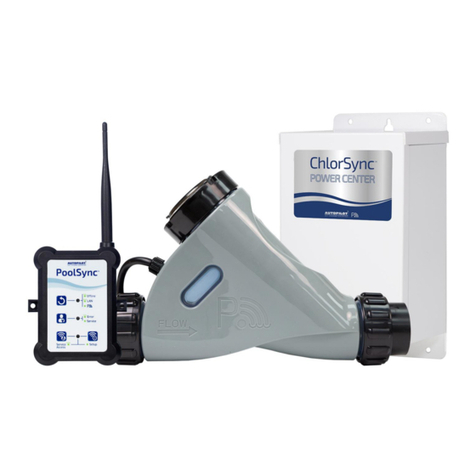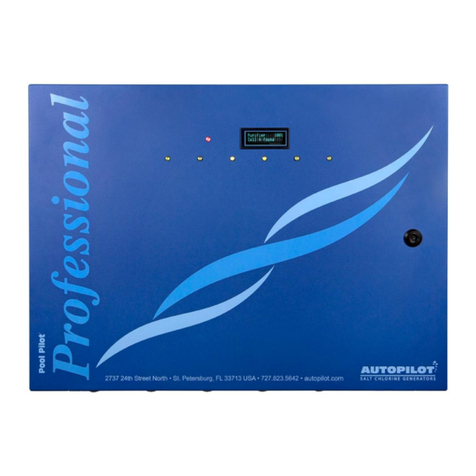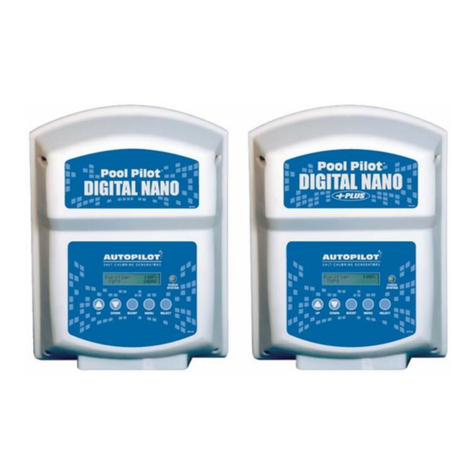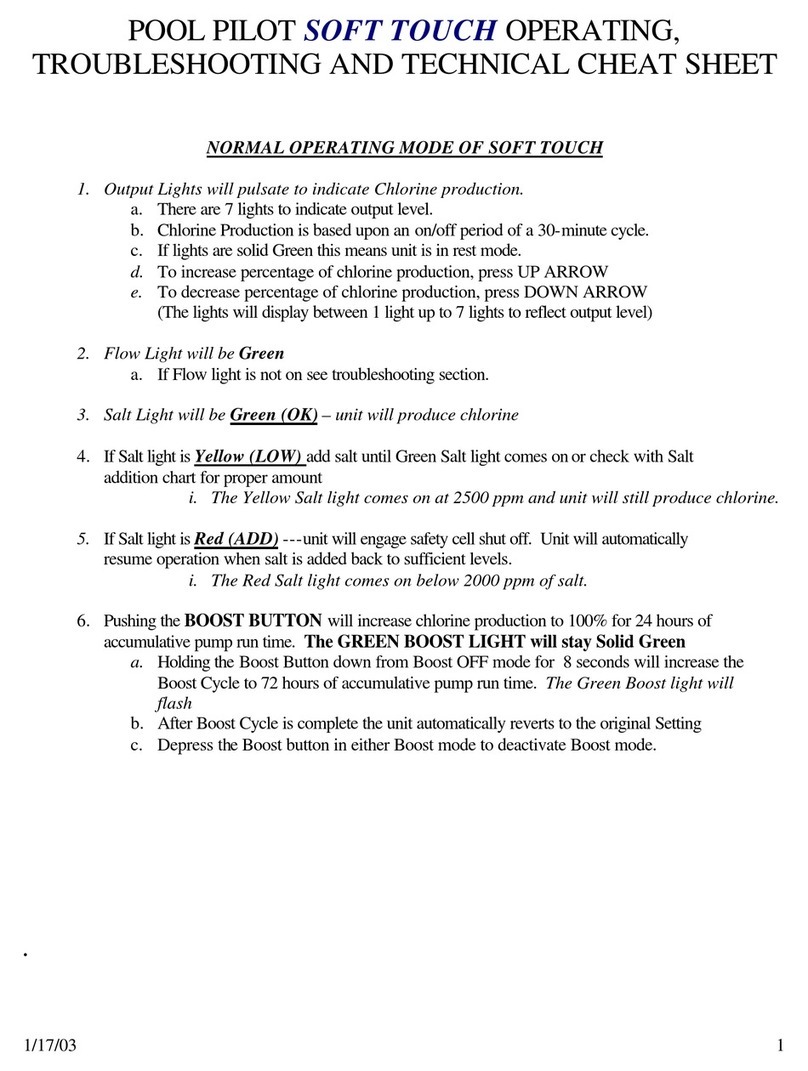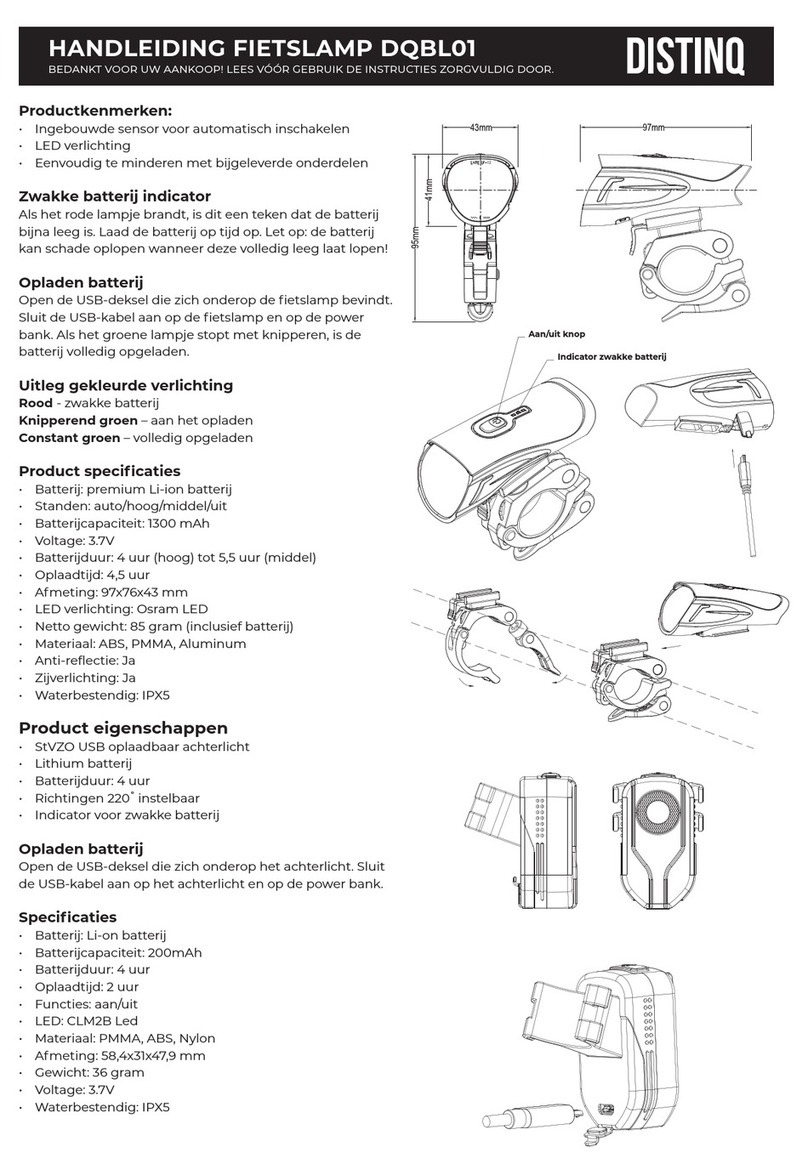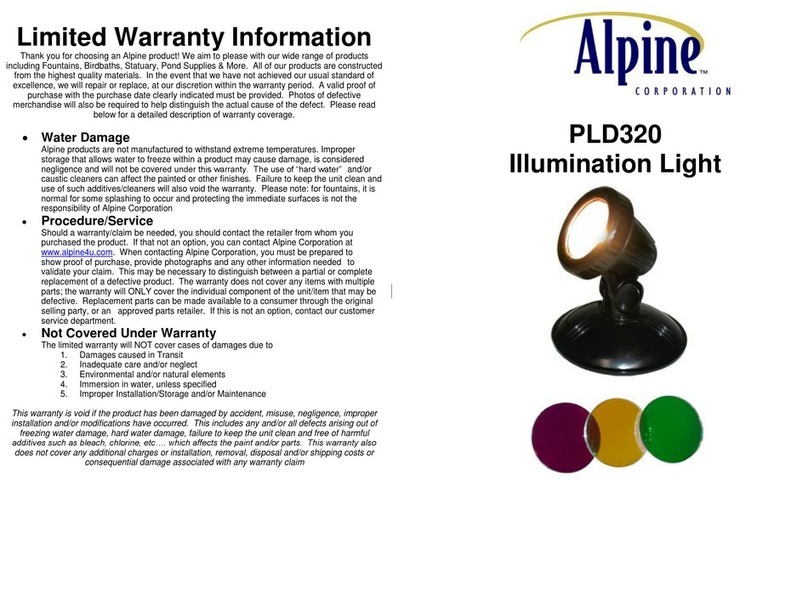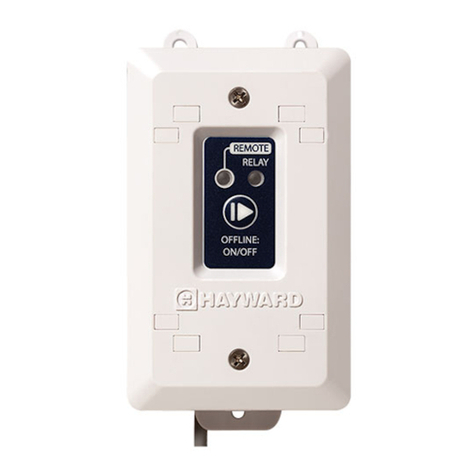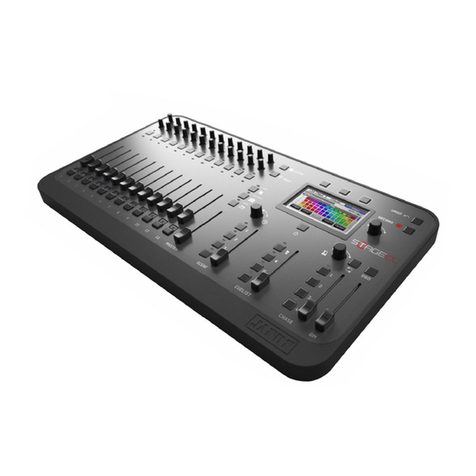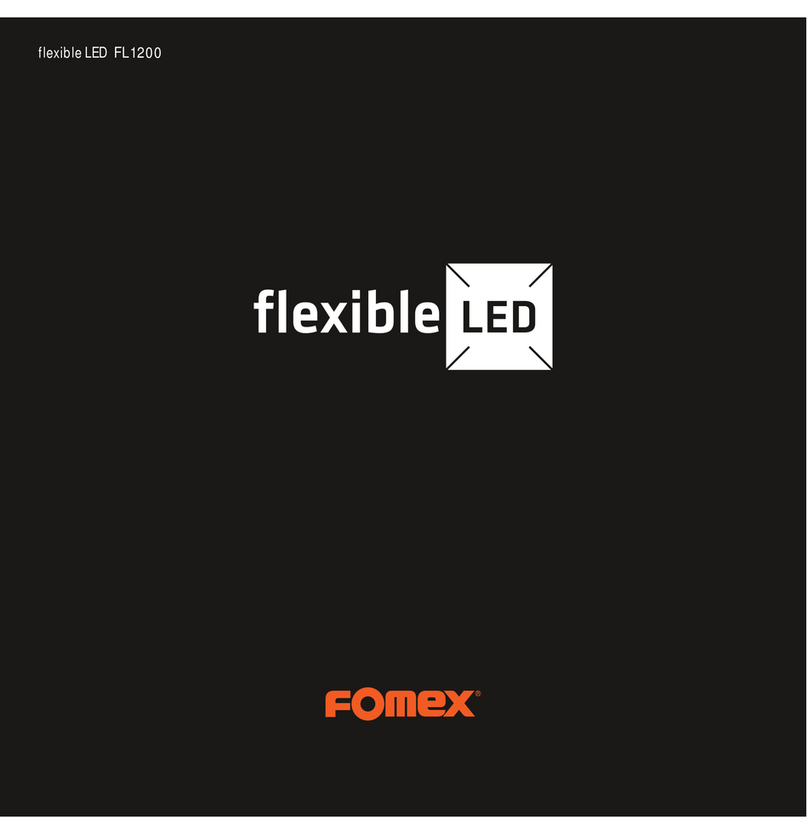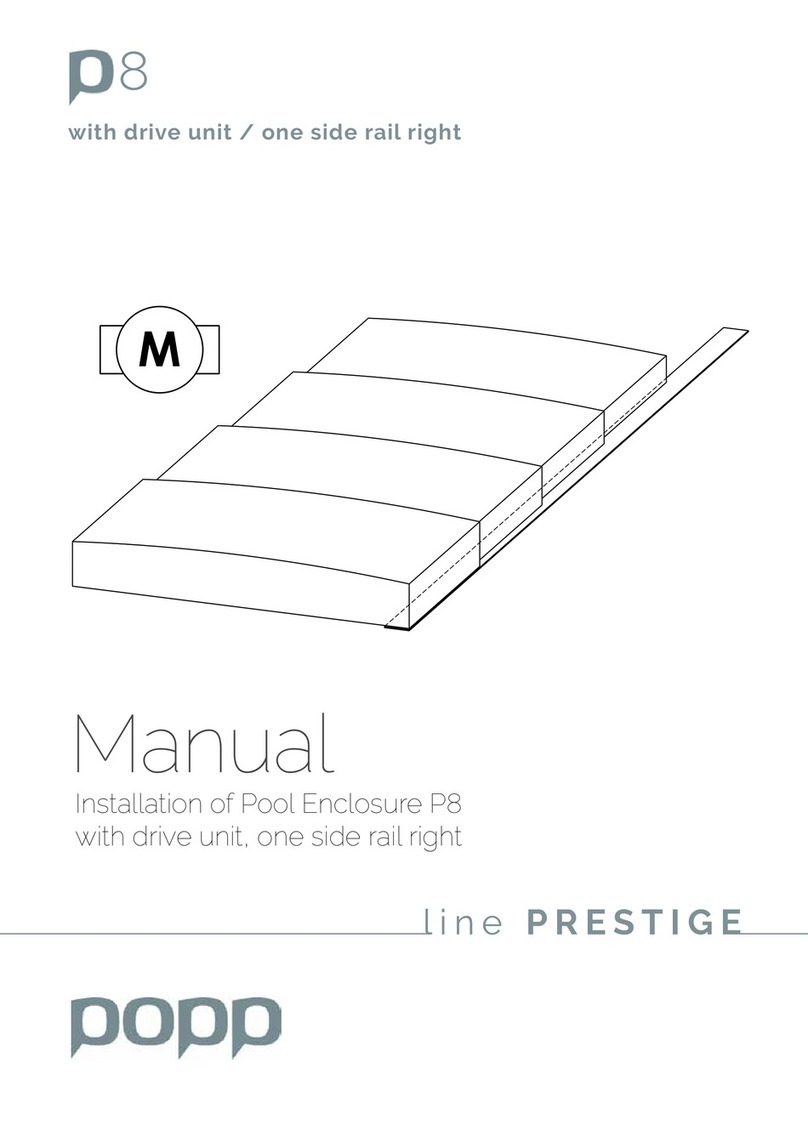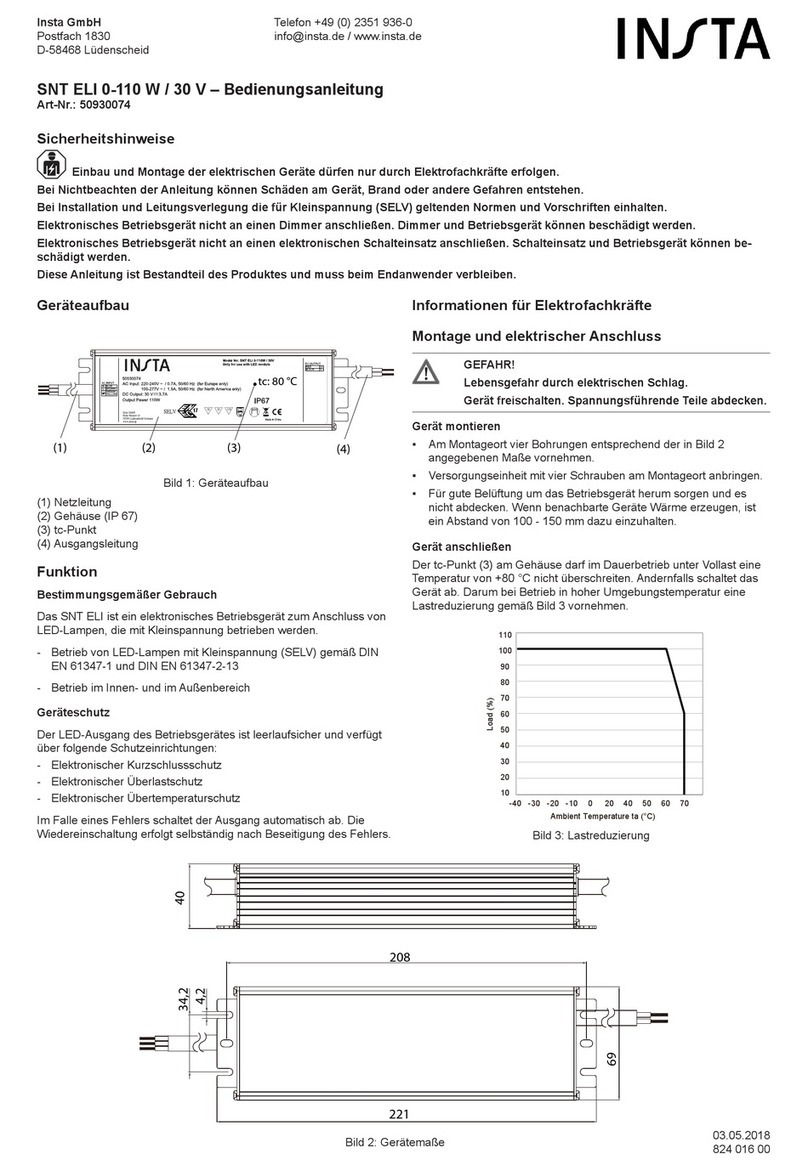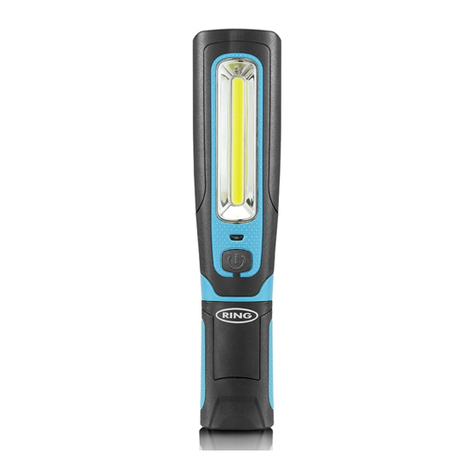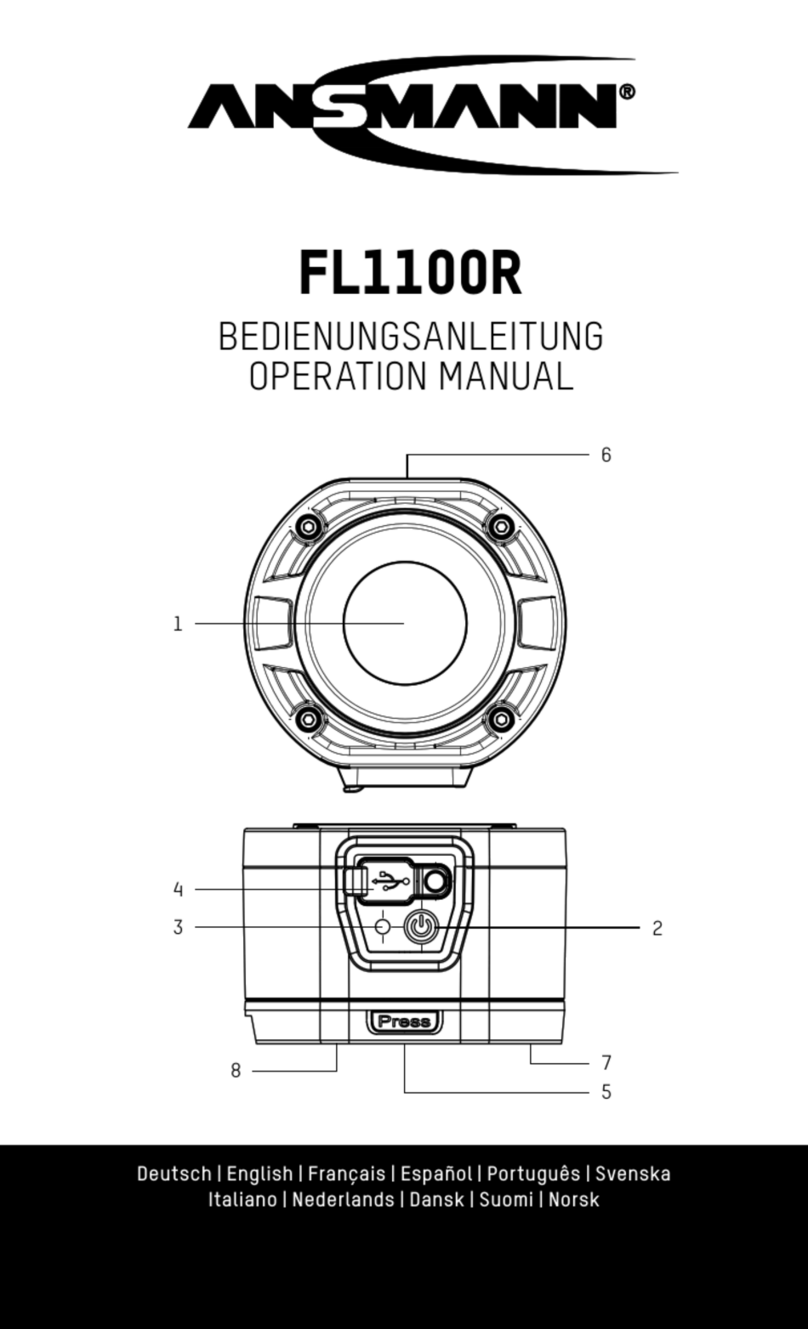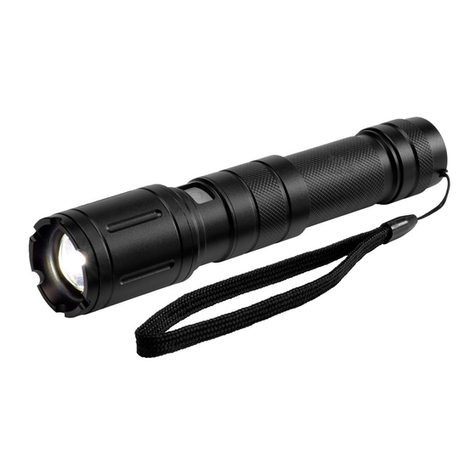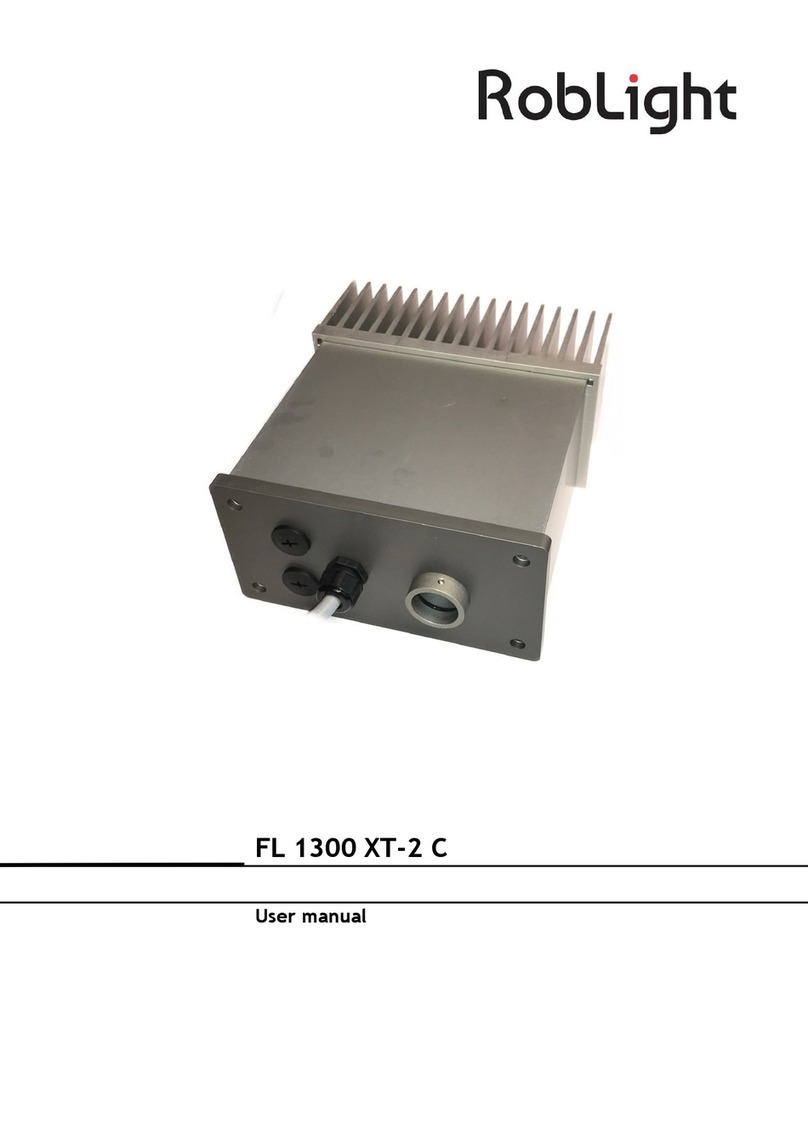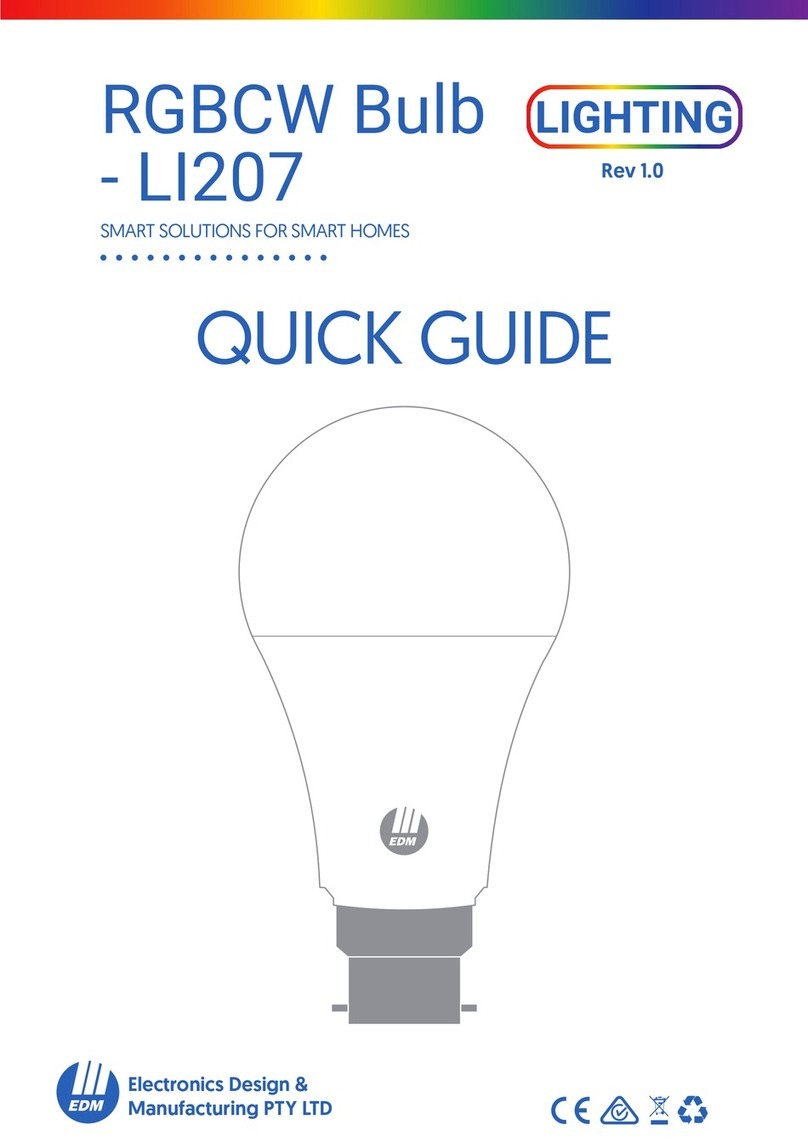Autopilot Pool Pilot Digital Nano+ User manual

INSTALLER: THIS DOCUMENT IS PURCHASER’S PROPERTY AND IS TO REMAIN WITH THE EQUIPMENT OWNER
LTP0086 Rev4 05/11/2017
Pool Pilot®
Digital Nano/Nano+
Digital Nano Models: 75041A, 75041A-xx
Manifolds: PPM1, PPM1M
Cell: PPC1
Digital Nano+Models: 75043A, 75043A-xx
Manifolds: PPM2, PPM2M
Cells: PPC1 or PPC2
Owner’s Manual: Installation / Operation
This manual covers the installation and operation of the Digital Nano/Nano+ Chlorine Generators
Important!
Read This Manual and Product Labels Before Installing or Operating This Equipment


Page i
TABLE OF CONTENTS
SECTION 1 - FACTORY CONTACT INFORMATION...........................................................................................1
SECTION 2 - SAFETY INFORMATION ................................................................................................................1
SECTION 3 - OWNER QUICK START & RUN.....................................................................................................4
3.1 How Your Digital Nano/Nano+ Works ............................................................................................................4
3.2 Optional 863A Expansion Board Additional Features ....................................................................................4
3.3 Owner/Operator Control Buttons, CHECK SYSTEM LED, and Audio Alarm.................................................5
3.3.1 UP and DOWN Arrows.................................................................................................................5
3.3.2 The BOOST Button......................................................................................................................5
3.3.3 MENU and SELECT Button .........................................................................................................5
3.3.4 CHECK SYSTEM Light and Audio Alarm ....................................................................................6
3.4 Normal Display Modes....................................................................................................................................6
3.4.1 Purifier Mode................................................................................................................................6
3.5 Water Balance and Chemistry Recommendations.........................................................................................7
SECTION 4 - SPECIFICATION AND APPROVALS.............................................................................................8
4.1 Specifications..................................................................................................................................................8
4.2 Manifold Pressure Drop Versus Flow .............................................................................................................9
4.3 Agency Approvals...........................................................................................................................................9
SECTION 5 -FEATURES....................................................................................................................................10
5.1 Patented Temperature Compensation..........................................................................................................10
5.2 Water Manifolds Assemblies - Available Options.........................................................................................10
5.2.1 Automatic-Flow Bypass Manifold Assembly (models PPM1, PPM1M and PPM2, PPM2M).....11
5.2.2 CoPilot®Manifold Assembly.......................................................................................................11
5.3 Automatically Reduce Chlorine Output When Pool Cover Closes ...............................................................12
SECTION 6 - MAINTENANCE.............................................................................................................................12
6.1 Fuse Location and Ratings...........................................................................................................................12
6.2 Removing / Inspecting / Cleaning Tri-Sensor...............................................................................................13
6.2.1 Tri-sensor Assembly Overview ..................................................................................................13
6.2.2 Inspect Tri-sensor.......................................................................................................................13
6.2.3 Cleaning Tri-sensor/Salt Sensor................................................................................................14
6.2.4 Test Tri-sensor Flow Switch.......................................................................................................14
6.3 Servicing the Cell..........................................................................................................................................15
6.3.1 Removal.....................................................................................................................................15
6.3.2 Visual Inspection........................................................................................................................16
6.3.3 Manual Cleaning ........................................................................................................................16
6.3.4 Installing.....................................................................................................................................16
6.4 Winterizing ....................................................................................................................................................17
6.4.1 Digital Nano/Nano+ Control Unit and Manifold Assembly .........................................................17
6.5 Spring Start-up..............................................................................................................................................17
6.5.1 Digital Nano/Nano+....................................................................................................................17
SECTION 7 - PROGRAMMING...........................................................................................................................18
7.1 Control Panel................................................................................................................................................18
7.1.1 Button Overview.........................................................................................................................18
7.1.2 MENU Button .............................................................................................................................18
7.1.3 Display Overview........................................................................................................................18
7.2 Menus ...........................................................................................................................................................19
7.3 Basic Operational Programming...................................................................................................................20
7.3.1 Adjusting the Chlorine Output %................................................................................................20
7.3.2 Boost or Super Boost.................................................................................................................20

Page ii TABLE OF CONTENTS
7.3.3 Chlorine Mode............................................................................................................................21
7.3.4 Chlorine % Adjustment Procedure.............................................................................................21
7.4 Test Pool Pilot (Diagnostic Menu) ................................................................................................................22
7.5 View Setup....................................................................................................................................................22
7.6 Review of Installer, Owner, & Maintenance Menu Programming.................................................................23
7.6.1 Set Pool Volume.........................................................................................................................23
7.6.2 Calibrate Salt..............................................................................................................................23
7.6.3 Select Language ........................................................................................................................23
7.6.4 Calibrate Temperature ...............................................................................................................23
7.6.5 Select Units ................................................................................................................................24
7.6.6 Set Temperature Unit.................................................................................................................24
7.6.7 Display Temperature..................................................................................................................24
7.6.8 Set 12/24 Hour Clock (Optional Feature w/ 863A Expansion Board)........................................24
7.6.9 Set Time of Day (Optional Feature w/ 863A Expansion Board) ................................................25
7.6.10 Set Purifier Off (Optional Feature w/ 863A Expansion Board).................................................25
7.6.11 Set Reverse Time.....................................................................................................................25
7.6.12 Force Reverse..........................................................................................................................26
7.6.13 Enable/Disable Audio Alarm ....................................................................................................26
7.6.14 Select System (Optional Feature w/ 863A Expansion Board) .................................................26
SECTION 8 - INSTALLATION.............................................................................................................................27
8.1 Basic System Overview................................................................................................................................27
8.2 Plannning the installation..............................................................................................................................28
8.2.1 Before installing the Digital Nano/Nano+:..................................................................................28
8.3 Check Parts ..................................................................................................................................................28
8.4 Installation Steps...........................................................................................................................................29
8.5 Mounting the Digital Nano/Nano+.................................................................................................................29
8.6 Electrical connections ...................................................................................................................................30
8.6.1 Electrical Connections Overview................................................................................................30
8.6.2 AC Input Voltage........................................................................................................................31
8.6.3 Low Voltage Wiring ....................................................................................................................31
8.6.4 Bonding ......................................................................................................................................34
8.7 Plumbing the system.....................................................................................................................................35
8.7.1 Plumbing the Manifold Assembly...............................................................................................35
8.8 Preparing the Pool Water..............................................................................................................................36
8.8.1 Steps to Prepare Water..............................................................................................................36
8.8.2 Calculating Pool Volume............................................................................................................36
8.8.3 Adding Salt.................................................................................................................................37
8.9 Programming at Installation..........................................................................................................................38
8.10 Language Translation Matrix ......................................................................................................................39
SECTION 9 - TROUBLESHOOTING...................................................................................................................42
SECTION 10 - REFERENCE.................................................................................................................................48
10.1 Basic Water Chemistry ...............................................................................................................................48
10.1.1 Chlorine....................................................................................................................................50
10.1.2 pH.............................................................................................................................................50
10.1.3 Total Alkalinity..........................................................................................................................50
10.1.4 Calcium Hardness....................................................................................................................50
10.1.5 Cyanuric Acid...........................................................................................................................50
10.2 Using the Saturation Index .........................................................................................................................51

Page iii
TABLE OF CONTENTS
10.3 Salt Addition Chart......................................................................................................................................52
10.4 Declaration of Conformity ...........................................................................................................................53
10.5 FCC Compliance.........................................................................................................................................53


Page 1
SECTION 1 - FACTORY CONTACT INFORMATION
If you should need to call AquaCal AutoPilot, Inc. for questions, services, or parts, please have your
model and serial numbers available. Please also have the name of your installer and date of your
equipment’s installation. If you have questions, please refer to our web site for the latest manual
revisions, additional information, and helpful service advice.
Web
www.AutoPilot.com
Pool Volume
(Gallons/Liters)
Phone
(727) 823-5642
8-5 pm, Est., M-F
Installer
Install date
Fax
877-408-8142
Cell Model
Serial #
Address
AquaCal AutoPilot, Inc.
2737 24th Street North
St. Petersburg, Florida 33713
USA
Digital Nano/Nano+
Model
Serial #
SECTION 2 - SAFETY INFORMATION
For personal safety, and to avoid damage to equipment, follow all safety instructions displayed on the
equipment and within this manual. Repair and service of your Digital Nano/Nano+ must be performed
by qualified service personnel. Should you suspect your chlorine generator is not performing properly,
refer to the section in this manual entitled: "Troubleshooting" on page 42 to determine if a call for
service is required. Warranties will be voided if the Digital Nano/Nano+ has been improperly installed.
Failure to properly operate, maintain or repair the Digital Nano/Nano+ will void the factory warranty.
Throughout this manual safety signals are placed where particular attention is required. Please note
"WARNING" signals relate to personal safety, while "CAUTION” signals promote avoiding damage to
equipment.
Follow all state provincial and NEC (National Electrical Codes) and applicable CEC (Canadian
Electrical Codes) unless local guidelines supersede. When installing and using your Digital
Nano/Nano+, basic safety precautions must always be followed, including the following:
WARNING: Failure to heed the following may result in injury or death.
RISK OF ELECTRICAL SHOCK - Disconnect all AC power when installing or servicing
this system. Follow all state, local, and National Electrical Code(s) (provincial and
Canadian Electrical Code(s) if applicable). Use copper conductors only.
RISK OF ELECTRICAL SHOCK - Digital Nano/Nano+ contains no owner-repairable
components. Repairs must not be attempted by untrained and/or unqualified individuals.
If service is deemed necessary, contact installing dealer or AquaCal AutoPilot Customer
Support.
RISK OF ELECTRICAL SHOCK - A bonding lug has been provided on the outside of the
Digital Nano/Nano+. This lug permits the connection of a No. 8 AWG (8.4 mm2) solid
copper-bonding conductor (No. 6 AWG in Canada). Make this connection between the
Digital Nano/Nano+ and all other electrical equipment and exposed metal within 5-feet
(1.5 m) of the Digital Nano/Nano+. All field-installed metal components (such as rails,
ladders, drains, etc.) within 10-feet of the pool, spa, or hot tub, must be bonded to the
equipment grounding bus using copper conductors not smaller than No. 8 AWG
(8.4 mm2) (No. 6 AWG in Canada).

Page 2
RISK OF ELECTRICAL SHOCK - Digital Nano/Nano+ configured to 115 Vac must be
installed at least 10 feet (3 m) from the pool or spa wall. Digital Nano/Nano+ configured
to 230 Vac must be installed at least 5 feet (1.5m) from the pool or spa wall.
RISK OF ELECTRICAL SHOCK - A disconnect device incorporated into the fixed wiring
must be included in the supply circuit (such as a time clock, relay, or circuit breaker).
RISK OF ELECTRICAL SHOCK - Connect only to a branch circuit protected by a
ground-fault circuit-interrupter (GFCI). Contact a qualified electrician if you cannot verify
that the circuit is protected by a GFCI.
RISK OF ELECTRICAL SHOCK - Digital Nano/Nano+ must be connected only to a
supply circuit that is protected by a ground-fault circuit-interrupter (GFCI). The GFCI
must be tested on a routine basis. To test, push the GFCI test button. Power should be
interrupted. Push the reset button. Power should be restored. If the GFCI fails to operate
in this manner, it is defective.
RISK OF ELECTRICAL SHOCK - If the ground-fault circuit-interrupter (GFCI) interrupts
power to the equipment without the test button being pushed, a ground current is flowing
with a possibility of an electrical shock. Do not use equipment. Disconnect the
equipment and have the problem corrected by a qualified service representative before
using.
CHEMICAL HAZARD - To avoid damaging splashes, always add acid to water, never
water to acid. Wear safety glasses and use other appropriate personal protection
equipment.
CHEMICAL HAZARD - Always follow the instructions on the manufacturer's label
whenever handling or using chemicals.
CHEMICAL HAZARD –Heavy pool (or spa) usage and higher temperatures may require
a higher chlorine output in order to maintain proper free available chlorine residuals.
WATER CHEMISTRY SAFETY - Improper water chemistry can present a serious health
hazard. The proper residual chlorine level and water chemistry must be maintained. The
addition of certain pool maintenance chemicals can reduce the effectiveness of chlorine.
Maintain Pool / Spa water per standards detailed later in this manual.
COMBUSTIBLE HAZARD –The AutoPilot®Digital Nano/Nano+ is equipped with an
electronic flow switch that automatically turns the unit off in the event of a “low water
flow” situation. Do not tamper in any way with this safety feature.
PERSONAL SAFETY HAZARD –To reduce the risk of injury, do not permit children to
operate this device.
RISK OF CHILD DROWNING OR INJURY - Children must be closely supervised at all
times around pool or spa equipment.
CAUTION: Failure to heed the following may result in equipment damage.
The AutoPilot®Digital Nano/Nano+ must be installed and operated as specified. Failure
to do so will void the equipment warranty.
To permit proper air circulation, the Digital Nano/Nano+ must be mounted at least 1-foot
(30 cm) above ground level or any other cooling obstruction.
Special measures are required in the event of freezing conditions. Your Digital
Nano/Nano+ may be damaged if measures are not taken in advance of freezing
conditions. Equipment damage due to freezing conditions is NOT covered under the
equipment warranty.
Do not use a pool cleaner or vacuum head with wheels, as wheels can leave track
marks on newly-plastered pools. Do not allow Granular salt to pile up in one location,
without brushing, as staining may occur.

Page 3
Excessively high chlorine levels can cause corrosion damage to pool fixtures and
equipment.
For maximum cell life, maintain water in a balanced condition. Water maintained in a
scaling condition will shorten cell life and may render the Digital Nano/Nano+
inoperative. Damage and/or service calls, caused by improper water balance, will NOT
be covered under the equipment warranty.
Scraping or scratching the titanium blade’s edge or surface will damage the blade
catalyst coating and cause premature failure of the cell... warranty will be voided. Never
use any sharp or metallic objects to remove scale.
Reduced polarity reversing cycle times will reduce cell life, and should only be used due
to uncontrollable scale formation on the cell. ALWAYS test and adjust water balance,
before attempting scale control via shortening reverse period.
The Tri-sensor should not be pulled out at an angle, or the flow paddle or flow post may
be damaged. SAVE THESE INSTRUCTIONS

Page 4
SECTION 3 - OWNER QUICK START & RUN
1) Balance the water chemistry according to the water chemistry parameters on page 7 and salt
recommendations on page 37. The Digital Nano/Nano+ may be started immediately. The salt
reading, however, may initially be inaccurate until the circulation pump has been run for 24
hours to fully dissolve newly added salt.
2) Use the UP and DOWN arrow buttons to set the chlorine percentage to 50%.
3) During the first two weeks, test the water chemistry parameters every 3-4 days. Adjust chlorine
percentage as needed.
4) Once ideal chlorine percentage has been determined, follow normal maintenance procedures.
3.1 HOW YOUR DIGITAL NANO/NANO+ WORKS
The Digital Nano/Nano+ is designed to handle the purification needs of residential swimming pools and
spas. The amount of chlorine required for proper sanitization will vary based on the pool size and
various factors such as water temperature, bather load, exposure to direct sunlight, and special water
features.
The system requires a low concentration of dissolved salt (sodium chloride) in the water. The salt
concentration level is normally maintained below the taste threshold. The Digital Nano/Nano+
automatically converts the salt into chlorine, which your pool/spa requires to remain sanitized and algae
free. The chlorine reverts back to salt after treating the water. Since the salt is constantly recycled,
there is minimal loss during a swimming season. However, salt can be lost due to filter backwashing,
rain water overflow, leaks, or bather splashing/carry out but not through evaporation.
The water circulation pump must be operating for your Digital Nano/Nano+ to produce chlorine, so run
time is one of several key components to maintaining the proper sanitizer levels. Most installations
require a minimum of eight (8) hours-per-day pump run time to properly filter and sanitize the water.
3.2 OPTIONAL 863A EXPANSION BOARD ADDITIONAL FEATURES
When the optional 863A Expansion Board is purchased and installed, your Digital Nano/Nano+ will be
equipped with a variety of additional features.
Once installed, the new board will support the addition of an automatic pool cover switch (not supplied)
that will detect when the pool cover is open or closed. This will allow the Digital Nano/Nano+ to
automatically adjust chlorine output when the cover is closed and avoid over chlorination or premature
cell depletion.
A 12/24 Hour Clock that allows the user to set personal preference for time display. The Set Time of
Day feature can be set to display the correct time zone and/or adjustments for Daylight Saving Time
changes. The optional 863A Expansion Board is also equipped with a Lithium battery backup for real
time clock.
The Set Purifier Off feature will allow the Digital Nano/Nano+ to be programmed to delay chlorine
production if salt will not be added to the pool water for a specified amount of time, from 1-28 days.
More detailed information on these features can be found in section 7.6, Review of Installer, Owner, &
Maintenance Menu Programming, on page 23.

Page 5
3.3 OWNER/OPERATOR CONTROL BUTTONS, CHECK SYSTEM LED, AND
AUDIO ALARM
The following is a brief explanation of owner or operator control buttons.
Please Note: This section assumes the installer has already programmed the system for specific site
parameters, has established proper water balance, and has pretreated water to 1 - 3 ppm (mg/L)
chlorine.
Attention Owner: Should Centigrade vs. Fahrenheit, choice of language, or other owner options require
modification, please refer to the programming information in section 7.6, located on page 23.
3.3.1 UP and DOWN Arrows
Use the UP and DOWN arrows to control the chlorine output level, then press the SELECT
button to save the value chosen. With a properly prepared pool, the recommended starting
output level is 50%.
Upon initial start-up, check sanitizer every 3-4 days and make small output level adjustments as
necessary to maintain 1 - 3 ppm (mg/L) free chlorine levels. Keep in mind, your Digital
Nano/Nano+ does not directly measure or regulate the sanitizer levels in your pool. Rather, the
owner / operator will need to periodically test the water to determine the current chlorine level,
and adjust the output setting as needed.
After the chlorine output level is “tuned in,” the unit will automatically make fine output
adjustments as the water temperature fluctuates. This temperature compensation feature will
adjust output depending on water temperature. See section 5.1 on page 10 for more information
concerning the Patented Temperature Compensation feature.
Please Note: The optimum output setting will vary based upon pool size, location, exposure to
sunlight, number of users, vegetation around the pool, water balance practices, and pump run
time. Your installer should have already taken these factors into consideration when performing
installation programming. Therefore, your adjustments, at this point, should be relatively minor.
3.3.2 The BOOST Button
The BOOST button increases output to 100%. Use this feature when a heavier than normal
bather load is anticipated.
Press BOOST once ............................. = 24 Hour Boost
Press and hold BOOST for 8 seconds . = 72 Hour Boost
Press BOOST a second time .............. = Deactivate Boost
3.3.3 MENU and SELECT Button
The “MENU” button allows the operator access to the “Test Pool Pilot”, “View setup”, “Owner
options”, “Maintenance” and “Installer” menus. (For full features of the Owner Options Menu,
please see page 23.)
Press the UP and DOWN arrows to scroll through the menus.
The “SELECT” button allows the operator to choose program menu options. The owner /
operator should not normally need to access these features on a regular basis.
Consult the Programming section on page 20 or contact factory customer support for additional
information.
A graphical overview of all the menus & sub-menus is shown in section 7.2 on page 19.

Page 6
3.3.4 CHECK SYSTEM Light and Audio Alarm
The CHECK SYSTEM light will flash to warn the unit may need attention. A warning message
will also be displayed. If enabled, an audio alarm* may also be heard when the system light is
flashing. Unless deemed a normal condition, per below, see the Troubleshooting section on
page 42.
Flashes red when pump is off / water flow is insufficient (It is normal for the light to flash if
the circulation pump is off)
Flashes when salt is low (check salt and add as needed)
Flashes when water temperature exceeds 125° F (51° C), or drops below 10° F (-12° C)
*Note: When enabled, an audio alarm will sound due to any of the above three (3) conditions. If
water flow ceases (or falls below minimum acceptable levels) the alarm will automatically
silence after 10 minutes. To enable or disable audio alarm, see section 7.6.13 “Enable/Disable
Audio Alarm” on page 26 in the programming instructions.
3.4 NORMAL DISPLAY MODES
The Digital Nano/Nano+ is limited to Purifier Mode.
3.4.1 Purifier Mode
Purifier (Chlorine Output %) level.............. Shown in 1% increments
Range with cover open .................... 0% to 100%
Range with cover closed.................. 0% to 20%
Water Temperature................................... Displayed in Fahrenheit or Celsius. The Temperature can
be turned off. See section 7.6.7, “Display Temperature” on
page 24 for more information.
CHECK SYSTEM Light ............................ Off when operating normally. Normally blinking red when
circulation pump is off and supply power to the Digital
Nano/Nano+ remains on. The light will also blink red when
an error has occurred. Refer to the Troubleshooting
section on page 42 for more information.
Example with the Retractable Pool Cover Open and the Temperature Display on.
Example with the Retractable Pool Cover Closed and Temperature Display off.
Display “A”
Display “B”
Cell Status……will show “On” when chlorine is being generated.
Field will be blank when the cell is off.

Page 7
3.5 WATER BALANCE AND CHEMISTRY RECOMMENDATIONS
Water balance is not complicated. It is the relationship between different chemical measurements in
your pool water. A pool that is balanced has proper levels of pH, Total Alkalinity and Calcium Hardness.
Balanced water can also be defined as water that is not corrosive or scaling. Water that is not balanced
can damage equipment and pool surfaces.
Proper water chemistry levels are essential to maintain safe and consistent swimming pool operation.
Sanitizers are used to destroy harmful or otherwise objectionable organisms. Stabilizer is used to
prevent unnecessary loss of chlorine to sunlight. Salt is used by the Digital Nano/Nano+ to generate
chlorine sanitizer.
Please note the following recommended water chemistry parameters are for residential pool/spa
applications only. Follow local regulatory guidelines for any commercial pool applications.
POOL
SPA
PARAMETER
UNITS
MIN
IDEAL
MAX
MIN
IDEAL
MAX
Free Chlorine
ppm (mg/L)
1.0
2.0 - 4.0
5
2.0
3.0 - 4.0
10
Combined Chlorine
ppm (mg/L)
0.0
0.0
0.2
0.0
0.0
0.5
pH
ppm (mg/L)
7.2
7.2 -7.8
7.8
7.2
7.2 -7.8
7.8
Total Alkalinity
ppm (mg/L)
60
80 - 100
180
60
80 - 100
180
Calcium Hardness
ppm (mg/L)
150
200 - 400
1000
100
150 - 250
1000
Salt
ppm (mg/L)
2000
2500 - 4500
**
2000
2500 - 4500
**
Cyanuric Acid (stabilizer)
ppm (mg/L)
0
30 - 50
***
0
30 - 50
***
Table 1
** Typically 6000 ppm (mg/L) or less is recommended; unit can operate with levels as high as
35,000+ ppm (mg/L).
*** This is dictated by state or local codes but is typically 100 ppm (mg/L).
See “Basic Water Chemistry”in section 10.1 on page 48, and “Using the Saturation Index”in section
10.2 on page 51 for further information concerning pool/spa water chemistry maintenance
requirements. Refer to the Troubleshooting section on page 42 in the back of this manual for
assistance with resolving low or high chlorine levels.

Page 8
SECTION 4 - SPECIFICATION AND APPROVALS
4.1 SPECIFICATIONS
SPECIFICATION
75041A,
75041-XX
(when converted
to 110V-120V in
the field)
75041A,
75041A-XX
75043A,
75043A-XX
(when converted
to 110V-120V in
the field)
75043A,
75043A-XX
Input Power:
110-120 Vac
2.0 A
220-240 Vac
1.0 A
110-120 Vac
2.0 A
220-240 Vac
1.0 A
Cell Maximum Chlorine Output:
PPC1
0.8 lb. /day (15.1 g/hr.) (standard)
0.8 lb. /day (15.1 g/hr.) (optional)
PPC2
not applicable
1.06 lb. /day (20.0 g/hr.) (standard)
Manifold Type
PPM1 or PPM1M
PPM2 or PPM2M
Standard Cell
PPC1
PPC2
Manifold Flow rates:
PPMxx (standard)
Minimum 15 gpm (57 L/min); Maximum 70 gpm (265 L/min)
CoPilot®Ozone (optional)
Minimum 25 gpm (95 L/min); Maximum 70 gpm (265 L/min)
Maximum Manifold
Pressure:
75 psi (517 kPa)
Cover Switch Compatible
Digital Nano/Nano+
models:
75041A & 75043A (Discontinued models 75040A & 75042A)
Table 2

Page 9
0
0.5
1
1.5
2
2.5
3
3.5
4
4.5
5
5.5
6
15 25 35 45 55 65 75 85 95
PSI
GPM
PPMxx & CoPilot®Ozone
Standard
(941xx)
CoPilot Ozone
0
5
10
15
20
25
30
35
40
50 150 250 350
kPa
LPM
PPMxx & CoPilot®Ozone
Standard
(941xx)
CoPilot Ozone
4.2 MANIFOLD PRESSURE DROP VERSUS FLOW
The following chart shows pressure drop versus flow for all Digital Nano/Nano+ manifolds. The optional
CoPilot®Ozone manifold is also listed. Table 3
4.3 AGENCY APPROVALS
Tested to conform to the following specifications:
SPECIFICATION
DESCRIPTION
UL1081
Safety Standard for Swimming Pool Pumps, Filters, and Chlorinators.
CAN / CSA-E60335-1
Safety of Household and Similar Electrical Appliances.
EU
See Declaration of Conformity in section 10.4 on page 53.
FCC
See FCC Compliance Declaration on page 53
PPMxx
PPMxx

Page 10
SECTION 5 - FEATURES
Patented temperature compensation for chlorine output control.
Programmable microprocessor control.
Multi-language digital display (English, Spanish, French, German, Italian and Czech).
Digitally controlled power to the cell.
Tri-sensor circuitry to monitor water flow, water temperature, and salt level.
Calculates and displays amount of salt needed to reach the recommended 3,000 ppm (mg/L)
salt concentration level.
Compatible with the optional 863A Expansion Board.
Can automatically reduce chlorine output when pool cover is closed. (Optional 863A Expansion
Board and Cover Switch must be installed.)
Chlorine production (salt addition) can be delayed for up to 28 days.(Optional 863A Expansion
Board)
Lithium battery (CR-2032) backup for real time clock (Optional 863A Expansion Board).
On board diagnostic and test programs.
Optional CoPilot®upgrade brings ozone to the pool.
5.1 PATENTED TEMPERATURE COMPENSATION
WARNING: Failure to heed the following may result in permanent injury or death.
Pool or Spa water temperature should not exceed 104°F (40°C).
The Tri-sensor temperature sensor works in conjunction with the chlorine % feature to automatically
adjust chlorine output based upon changes in water temperature. The automatic compensation feature
operates between 55°F and 125°F (13°C - 52°C).
As water temperature falls below 65°F (18°C), the controller will automatically reduce the chlorine %
and will reduce the maximum % that can be selected. This feature prevents the controller from
generating excessive chlorine in cold water where it is not needed and prevents premature cell failure.
At 55°F (13°C) or colder water temperatures, the controller will adjust to a fixed 1% output, thus
preventing over-chlorination and premature cell failure.
5.2 WATER MANIFOLDS ASSEMBLIES - AVAILABLE OPTIONS
CAUTION: Failure to heed the following may result in equipment damage.
The Digital Nano manifold may only use the PPC1 cell. The Digital Nano+
may use either the PPC1 or PPC2 cell.
The Digital Nano uses the patented automatic-flow bypass manifold assembly (models PPM1,
PPM1M). The Digital Nano should ONLY use the PPC1 cell.
The Digital Nano+ uses the patented automatic-flow bypass manifold assembly (models PPM2,
PPM2M) with a PPC2 cell. The Digital Nano+ may also use a PPC1 cell but the maximum chlorine
output will be lower. See the Specifications table in section 4.1 on page 8.
The CoPilot®manifold assembly comes with an automatic-flow bypass, check valve assembly and
ozone injector venturi assembly.

Page 11
5.2.1 Automatic-Flow Bypass Manifold Assembly
(models PPM1, PPM1M and PPM2, PPM2M)
The AutoPilot®patented manifold is connected into
the plumbing after all other equipment. Water from
the pool/spa is moved though the manifold by the
circulation pump. The manifold uses four key
components:
The Tri-sensor provides data (from electronic
sensors) to the Digital Nano/Nano+ for
monitoring water flow, water temperature, and
salt concentration level. The Digital Nano/Nano+
uses this data to determine if conditions are
suitable for the cell to operate; the signal read
from the temperature sensor allows the
automatic temperature compensation feature to function.
The Cell (PPC1 or PPC2) receives power from the Digital Nano/Nano+ and converts
the salt contained in the water to chlorine.
The Strainer Screen prevents debris in the water from entering the Tri-sensor or cell, and
requires periodic inspection and cleaning.
The Bypass Check Valve allows the water flow rate to be slowed and optimized through the cell,
while permitting the pump to continue to circulate water to-and-from the pool/spa at full flow rates.
The reduced water flow through the cell results in a more efficient "Super-Chlorination” effect,
resulting in improved overall sanitization.
5.2.2 CoPilot®Manifold Assembly
The CoPilot®system is designed to be used in
conjunction with the Digital Nano/Nano+ to reduce
chlorine demand and extend cell life. This system is also
sold separately as an upgrade to existing Digital
Nano/Nano+ systems.
The manifold is connected into the plumbing after all
other equipment. Water from the pool/spa is moved
though the manifold by the circulation pump:
The Tri-sensor provides data (from electronic sensors)
to the Digital Nano/Nano+ for monitoring water flow,
water temperature, and salt concentration level. The
Digital Nano/Nano+ uses this data to determine if
conditions are safe for the cell to operate; the signal
read from the temperature sensor allows the automatic temperature compensation
feature to function.
The Cell (PPC1 or PPC2) receives power from the Digital Nano/Nano+ and converts the salt
contained in the water to chlorine.
The Strainer Screen prevents debris in the water from entering the Tri-sensor or cell, and
requires periodic inspection and cleaning.
The Bypass Check Valve allows the water flow rate to be slowed and optimized through the cell,
while permitting the pump to continue to circulate water to-and-from the pool/spa at full flow rates.
The reduced water flow through the cell results in a more efficient "Super-Chlorination” effect,
resulting in improved overall sanitization.
The Ozone Venturi Injector introduces ozone directly into the water before the Digital
Nano/Nano+ cell. The ozone venturi injector is connected to the CoPilot®via an Ozone Check
Valve and Tube Assembly (not shown).
Tri-sensor
Ozone Venturi
Injector
Cell
Bypass Check Valve
Strainer
Screen
Tri-sensor
Cell
Strainer
Screen
Bypass Check Valve
Figure 1
Figure 2

Page 12
5.3 AUTOMATICALLY REDUCE CHLORINE OUTPUT WHEN POOL COVER
CLOSES
When the pool cover is closed, the Digital Nano/Nano+ will automatically reduce the chlorine output to
20% of the normal open cover setting.
*This only applies to models that are equipped with the optional 863A Expansion Board and the
cover position switch is connected to the unit. See “Connecting the Retractable Cover Switch” in
section 8.6.3 on page 32 for more information.
SECTION 6 - MAINTENANCE
6.1 FUSE LOCATION AND RATINGS
WARNING: Failure to heed the following may result in permanent injury or death.
ELECTRICAL SHOCK HAZARD –Turn off the electrical power to unit before
servicing.
To inspect or service fuse, disconnect power and remove power center cover (see below for location of
fuse). Ratings
BOARD
FUSE SPECIFICATION
DESCRIPTION
Main Power Board When Converted to 115V
75041A, 75043A, 75041A-xx, 75043A-xx
250 Vac 2 Amp Slo Blo
Main AC Power Fuse for
115 Vac operation
Main Power Board (Factory set as 230 Vac)
75041A, 75043A, 75041A-xx, 75043A-xx
250 Vac 1 Amp Slo Blo
Main AC Power Fuse for
230 Vac operation
Location of Fuse
Fuse
Figure 3
Figure 4

Page 13
Tri-sensor Assembly
Flow Paddle
Salt Sensor Blades
Temperature
Sensor Post
Tri-sensor
O-Ring
Indicator of
Flow Direction
6.2 REMOVING / INSPECTING / CLEANING TRI-SENSOR
6.2.1 Tri-sensor Assembly Overview
The Tri-sensor Assembly is used to measure water flow, salt level, and water temperature.
Note: The use of high strength magnet devices in the close proximity of the Tri-sensor can
cause the flow switch to function incorrectly.
When the water flow reaches a minimum
flow rate of 15 gpm (76 L/min), the flow
paddle magnet closes a micro-switch
monitored by the Digital Nano/Nano+.
The CoPilot®Ozone manifold requires a
minimum flow of 25 gpm (95 L/min).
The Digital Nano/Nano+ uses dedicated
salt sensor blades to measure the level
of salt in the water.
The Digital Nano/Nano+ uses the
temperature sensor to determine water
temperature. This measurement is
required for the Patented Automatic
Temperature Compensation feature to
automatically adjust chlorine output as water temperature varies. Less chlorine is needed
in cold water, so chlorine output is automatically reduced as water temperature drops
(avoiding excess chlorine production). Conversely, more chlorine is needed in warmer
water, and production is automatically adjusted higher as water temperature increases.
Please note - The Tri-sensor normally does not require maintenance or cleaning.
6.2.2 Inspect Tri-sensor
1) Disconnect the Tri-sensor cable from the power center.
2) Remove the two (2) screws retaining the Tri-sensor in the Tee joint of the Manifold.
Note the orientation of the Directional of Flow Tab. The Tri-sensor must be installed in
the same orientation when it is reinstalled or replaced.
3) The Tri-sensor can now be pulled out of the Tee.
CAUTION: Failure to heed the following may result in equipment damage.
The Tri-sensor should not be removed from manifold at an angle, or the flow paddle
and/or flow post may be damaged.
Firmly grip the Tri-sensor assembly (this is typically done with a large pair of channel lock
pliers).
Twist the Tri-sensor back-and-forth while simultaneously pulling the Tri-sensor straight
out of the Tee joint.
4) Check the Tri-sensor assembly for any damage to the plastic housing and replace if needed.
5) Inspect the following on the flow switch:
Verify the thin metallic paddle is straight and free from erosion.
Verify the plastic post is straight and free of cracks. (Do not twist or bend the paddle or
the plastic post.)
6) Inspect the two salt sensor blades. The blades should not have any mineral deposits (scale)
or other debris on them.
Figure 5

Page 14
Water
Flow
7) Do not use any metallic objects to scrape the blade surfaces or you will remove or damage
the blade sensor coating.
6.2.3 Cleaning Tri-sensor/Salt Sensor
If required, you can remove a calcium scale buildup by creating a solution of water and muriatic
acid as follows. Do not use any metallic objects to scrape the blade surfaces or you will remove
or damage the blade sensor coating.
WARNING: Failure to heed the following may result in permanent injury or death.
CHEMICAL HAZARD - To avoid damaging splashes always add acid to water, never
water to acid. Wear appropriate personal safety protection including safety glasses
when using pool chemicals.
1) Mix the solution in a small container tall enough to cover the sensor blades. DO NOT add
water to acids; always add acid to water in container.
2) Mix one (1) part muriatic acid into four (4) parts water.
3) Immerse the salt sensor blades in the solution for up to 15 minutes. An effervescing
action indicates the calcium is being dissolved from the blades.
4) Rinse with fresh water and re-inspect. Repeat the acid treatment as necessary until all
scale has been eliminated.
6.2.4 Test Tri-sensor Flow Switch
WARNING: Failure to heed the following may result in permanent injury or death.
Do NOT operate system with a faulty water flow switch.
The Flow Switch is a critical equipment protection device to prevent damage to the cell or
system. When water flow has stopped, power to the cell is automatically turned OFF. It is
important to verify the proper operation of the Tri-sensor’s water Flow Switch protection device.
The following procedure can be used to verify the proper operation of the flow switch, or to flush
debris from the Bypass Valve.
1) Turn off the circulation pump.
2) Slightly loosen the union nut just below the
cell on the side of the manifold that does not
contain the filter screen. (A strap wrench may
be required.)
3) Completely loosen the manifold union nut that
contains the filter screen and pivot the
manifold to gain access to the filter screen.
4) Remove the screen. Clean the screen if dirty.
5) If the screen was dirty, then the system may
need to be purged to remove excess
debris. Leave the manifold off and run
the pump for a few seconds until
clear.
STRAINER SCREEN SHOWN
TEMPORARILY WRAPPED IN PLASTIC
Figure 6
Bypass Valve
This manual suits for next models
3
Table of contents
Other Autopilot Lighting Equipment manuals
